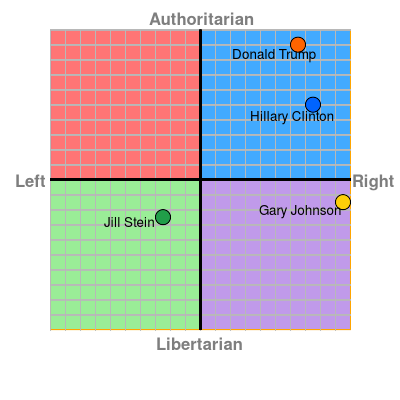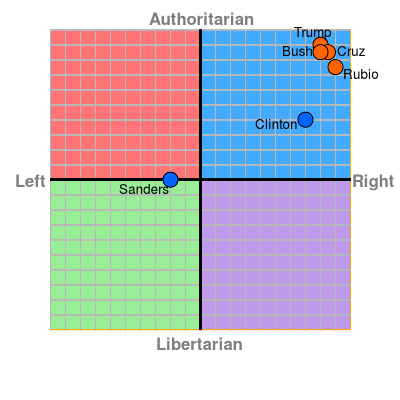The US Presidential Candidates 2016

Please note that the positions on the chart are based on speeches, manifestos and, where applicable, voting records. If positions markedly change during the campaign, we will revise the chart accordingly. Already the positions of Trump and Clinton differ slightly from the primaries chart.
Despite most polls indicating that Bernie Sanders would fare significantly better than Clinton against Trump, the party clearly wanted Hillary. This surely suggests that when push comes to shove, the Democratic establishment would prefer Hillary to lose the presidency than Sanders to win it. On the other hand, a large section of the GOP mainstream is probably uncomfortable enough with their blustering billionaire to swing behind Hillary — but never Sanders.
It remains a mystery to us why Sanders chose to describe himself — incorrectly — as a socialist, and in America of all countries. His position is that of a mainstream social democrat — a Keynesian in the mould of the New Deal, and the mainstream left in all other democracies. You wouldn’t need a degree in marketing to see that ‘social democrat’ would be a much more appealing self-description, so why did he insist on such an unhelpful misnomer? It was helpful, though, to his right wing primaries opponent, who was able to present herself as a centrist, between an off the wall socialist and a quasi-fascist. In this most paradox-packed electoral circus, some of Trump’s professed economic positions are actually closer to Bernie’s than to Hillary’s. Trump’s extremism is on the social scale rather than the economic one. Like Sanders — and unlike Clinton — Trump supported a decent minimum wage from the start, wants free education in state universities, has supported universal health care, consistently opposed the Transpacific Partnership Agreement and wants more bank regulation. Considering the cosy relationship that the Clintons and Trump have enjoyed until almost yesterday (reflected by Trump’s generous support for both Hillary’s senatorial campaigns and the Clinton Foundation) the mercurial Donald’s differences may be less than they presently appear. Is it beyond all possibility that a Trump ‘bi-partisan’ presidency might include a role for his old friend Hillary?
Sanders now unequivocally supports the Democratic nominee, yet his positions are actually far closer to those of Jill Stein, leader of the Greens. The party that Bernie barely belongs to is apparently more important than the principles that he’s passionately espoused for so long. In the twilight of his political career Sanders might have taken a bolder move than merely conforming to the expectations of ideologically arthritic liberals who will settle for a lesser-of-two-evils electoral exercise, as they have done for decades. Instead Sanders wants to rally his impressive legion of supporters behind a candidate representing the very things that they’ve been consistently revolting against! Was he so terrified by the prospect of a Trump presidency that he dumped the chance to strike a real blow against the one percent by joining Stein and launching the most formidable third party challenge in decades? Or might he have been a Judas sheep all along? Clinton can now be expected to toss a few crumbs to the Sandernistas in an attempt to prevent them bolting to the Greens. Whatever she says about issues like the minimum wage, the Trans-Pacific Partnership Agreement, fracking and Medicare between now and November is unlikely to be honoured in office. Even if she wanted to break the habit of a career and significantly swing towards the 99 percent, her donors like Walmart, McDonalds, Wall Street and so many others simply wouldn’t permit it.
It’s a measure of how far the fulcrum has swung to the right that under President Eisenhower (1953-61) — a Republican no less — the top tax rate was just over 90 percent. Sanders, however, has been depicted in much of the mainstream media as ‘far-left’ for wanting to raise the tax ceiling to 52 percent!
The Greens and the Libertarians have been shamefully sidelined by a skewed system that cries out for democratic reforms, serious curbs on corporate campaign funding and the implementation of a form of proportional representation that most democracies take for granted.
There is no stronger single indicator of authoritarianism and state power than a willingness to execute. A number of Libertarian Party supporters have correctly pointed out to us that, contrary to our assertions, Gary Johnson no longer supports the death penalty. (According to On The Issues and other sources, in 1996 Johnson said that he even favoured capital punishment in certain circumstances for children as young as 13 and 14. The following year he introduced a bill to actually expand the death penalty.) However he no longer supports it because of the risk of innocent people being executed. This is nevertheless a far less socially libertarian position than that held by Jill Stein, an unequivocal life-long opponent of the principle of state executions, regardless of innocence or guilt. While Johnson now sees the death penalty as ‘flawed’, Stein describes it as ‘barbaric’. In certain other social issues they hold similar perspectives. Economically they differ enormously. Johnson holds deep admiration for Ayn Rand (The Virtue of Selfishness) whose social Darwinism is anathema to the Green Party leader. Stein, like Sanders, identifies the incompatibility of the prevailing economic orthodoxy with the ecological imperative.
Are the fat cat vulgarian and the hawkish pin-up girl of Wall Street really the finest minds and noblest characters that America could come up with for its highest office? Identity politics will, again, triumph. We’ve had a black leader. Now it will be cool to have a woman, right? Thinking progressives, however, might reflect on the uncomfortable truth that a President Trump would be relentlessly scrutinised, criticised and checked not only by the Democrats, but also by many in his own party. Conversely, a Democratic president, ultimately more different in style than substance, would implement a largely Republican agenda in all but name and get a relatively easy ride. Haven’t the last eight years of neo-conservatism and Democratic deference brought the country too close already to a one-party state masquerading as a two-party state?
We include below our earlier primaries chart for comparison.


